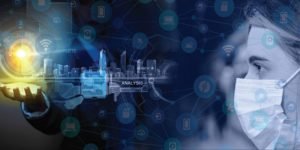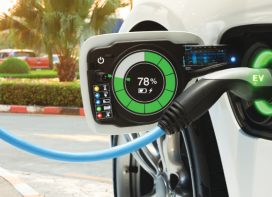These pandemic days are posing challenges to Smart Cities too. Traffic levels and mobility patterns can alter, as digital transformation takes hold. What are the challenges? We have here the views of Raj Cherubal, CEO, Chennai Smart City and Sameer Bhatnagar, Partner- Transport& Logistics, KPMG, India
 Contrary to what may be expected in the era of social distancing, it is a good opportunity to aggressively transform public transport especially buses, metro rail, train, but also drastically expand infrastructure for, cycling, e-bikes, etc. Even in pre-pandemic times, a small percentage of citizens owned cars yet they disproportionately occupied road space – cause the terrible congestion, pollution and chaos on Indian streets. Our streets are choked with private vehicles. So rest of the population owning private vehicles for distancing is not a practical model,” says Cherubal.
Contrary to what may be expected in the era of social distancing, it is a good opportunity to aggressively transform public transport especially buses, metro rail, train, but also drastically expand infrastructure for, cycling, e-bikes, etc. Even in pre-pandemic times, a small percentage of citizens owned cars yet they disproportionately occupied road space – cause the terrible congestion, pollution and chaos on Indian streets. Our streets are choked with private vehicles. So rest of the population owning private vehicles for distancing is not a practical model,” says Cherubal.
“So walking, public bike sharing, cycling, including last mile vehicles can help immensely. But to bring down the congestion and move more people with distancing, we need to aggressively deploy buses and other mass transit. Even earlier our cities had in adequate number of buses. Alternate financing models like value capture, PPP, separation of subsidies from measuring efficiency of public transport corporations etc need to be implemented to fund this.
“For example, Chennai has 3500 odd buses. Experts believe the number should be 6000-12000. So the new reality insists that we have many more buses than that. Plus if all cities of the country were to take up this strategy, this would be a huge employment generation mechanism, with much of the vehicle industries re-structuring to make modern low cost A/C buses.’’

Raj Cherubal
Initially, the buses might carry one-third of passengers. So, to reach certain demand levels, the buses would need to run more trips. This will require use of route optimisation tools for real time dynamic routing of buses, and use of contactless payment & ticketing.- Raj Cherubal
Cherubal gives a health angle to this as well. Indian increasingly suffer from lifestyle diseases like diabetics and cardiovascular due to lack of exercise, places to walk and relax. COVID-19 crisis has impacted these citizens more than others. Lack of walking, cycling, public space infra, and unsafe and polluted public environment in our cities has largely contributed to this state of affairs. “We cannot carry on as business as usual – with ever increasing numbers of cars destroying our public space and streets with chaos, pollution, haphazard parking. The crisis needs to be used to win the war against these menaces for current and future generations, once and for all.”
Bhatnagar points out three main challenges for the transport sector. One is operational challenge. During rush hour, public transport systems can be crowded. Thermal screening may lead to long queues requiring holding areas, contactless ticketing systems, sanitisation of bus and metro coaches etc. Financial challenges are the outcome of low ridership. Though low income group is largely dependent on public transport, this segment might not pay for non-fare activities such as kiosks etc. Moreover, many labourers have possibly migrated back to their hometowns – so their availability in cities is going to be lower. “ Drop in ridership also reduces advertising and real estate revenues as footfalls decrease. Altogether, revenues for public/bus transport will drop affecting their sustenance and putting pressure on state finances,” explains Bhatnagar.
When it comes to mobility pattern, it is expected that the demand for private modes of transport – Auto/ Private cabs/ private cars/bikes will increase. This will put more load on the road and will lead to traffic congestion. The intent of using public transport would get a set-back.

Bhatnagar
“Hence, a lot of digital transformation that was to promote multi-modality, journey trip-time optimisation, greater use of public transport might get a set-back for some period till the time people resume and return to using public transport. In the interim, technology can be used to monitor traffic even more than before, enforce containment zone travel, use smart cameras for enabling faster thermal scanning or use of face masks, advise on bottlenecks and re-routing etc.
The focus should be on embedding technology in city systems for not only BAU (Business as Usual) operations for efficiency & productivity but also for proper management during difficult times. The drive for improving efficiency and cost control would be imperative given the difficult economic situation for most government authorities, arising out of the pandemic.- Bhatnagar
– Bhatnagar
During these months Smart City components Central Control Centres, new surveillance technologies, drones, telematics, etc are being put to multiple applications. What are the impacts on Smart city projects?
“These technologies are tools that could help leapfrog to a better level of governance,” says Cherubal. “These are not substitute for regular planning, design, infra and services. But technology can help shorten the cycle of this development. Other countries have had many decades to reach a level of quality of life – via the traditional route of planning and implementation and operations/maintenance, in iterations. We have limited resources and time to catch up. So newer technologies can help shorten the cycle, help monitor projects and upkeep of infrastructure being created and also help gather useful data with very limited staff and funds. Drones and satellites can help keep an eye on our water bodies and precious resources from encroachments. Telematics, data/IoT etc can help proactively manage health and control spread of diseases.”
According to Bhatnagar, the role of technology is likely to get more pronounced as cities see technology as the key to managing and monitoring crises. COVID-19 is an unique situation that has impacted all aspects of city life and operations, resulting in stress testing most city systems. While, we are already facing this pandemic, there is a possibility of other challenges in future like earthquake, floods, social unrest, terrorist incidents, vector borne epidemics that would need effective management and monitoring. In such situations, technology has come to be a big relief and support.
Drone based surveillance of curfew areas, technology based detection of suspicious vehicles, goods or persons, delivering essential relief and services using smart phones & drones or secure vehicles; IOT based monitoring of health & operation of assets such as utilities during normal and stress times; location tracing, activation and mobilisation of emergency assets/ resources, dashboarding; interdepartment communication etc. are large and important technologybased solutions that could likely get expedited and developed as cities try to get a faster and stronger grip on city-wide systems under one integrated platform.
 TrafficInfraTech Magazine Linking People Places & Progress
TrafficInfraTech Magazine Linking People Places & Progress


